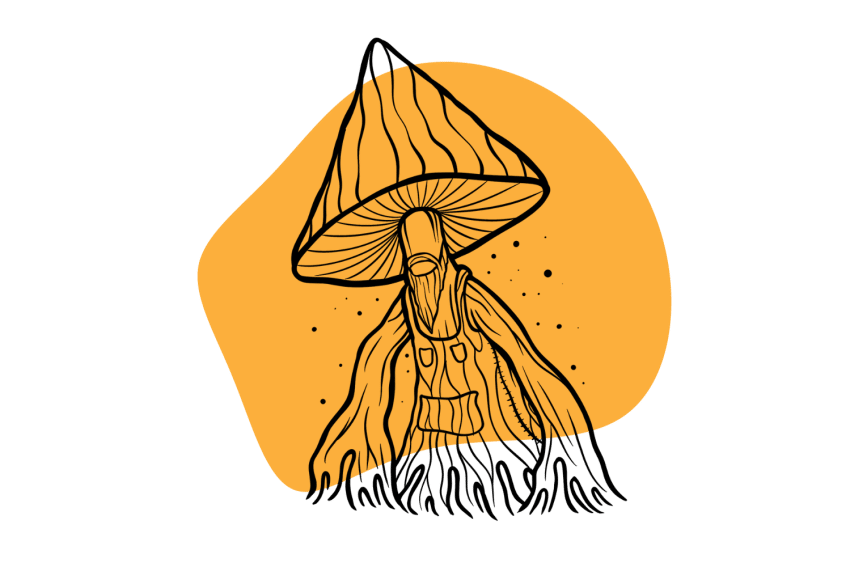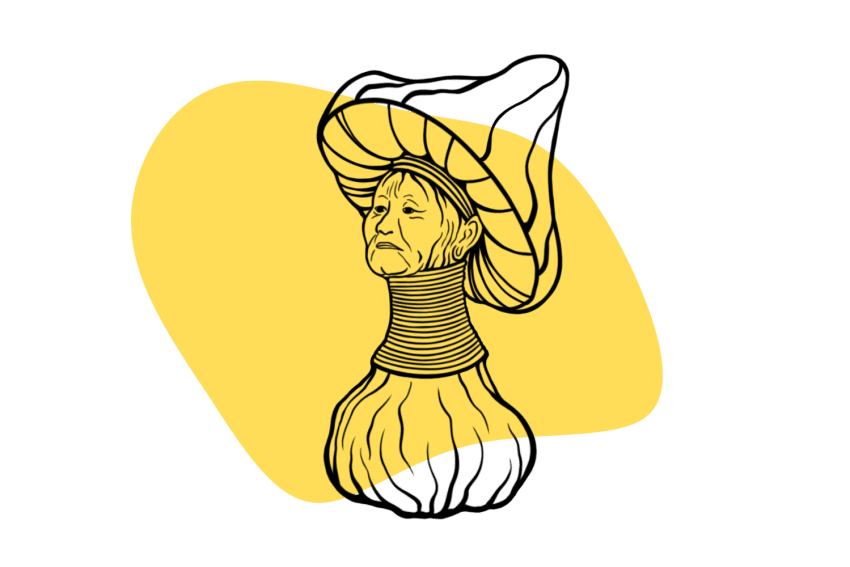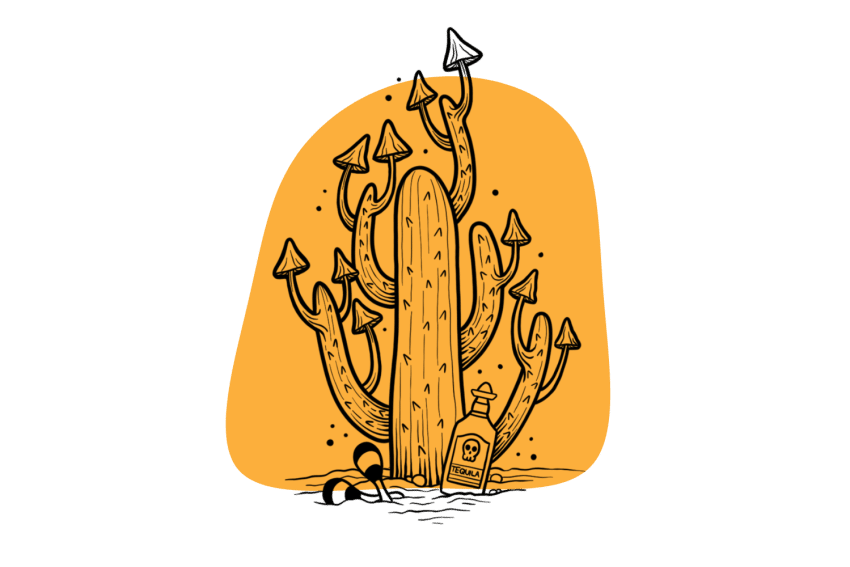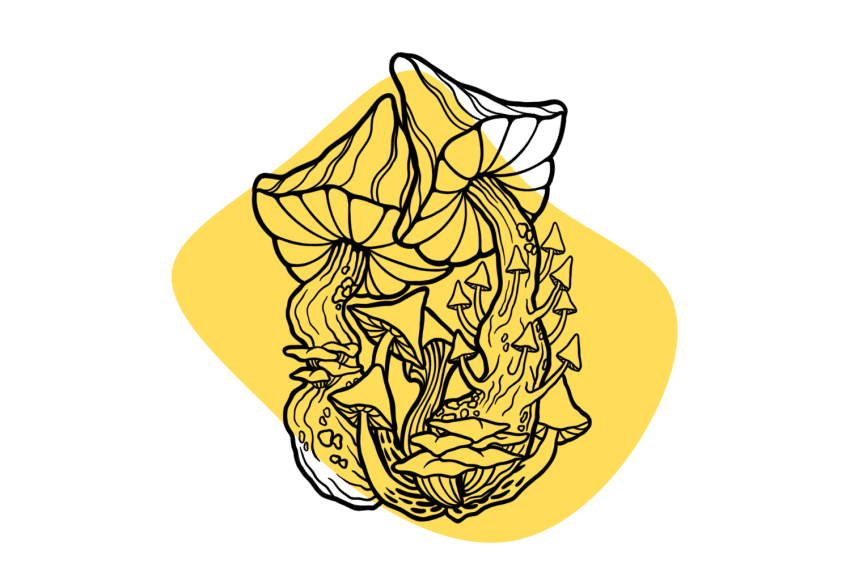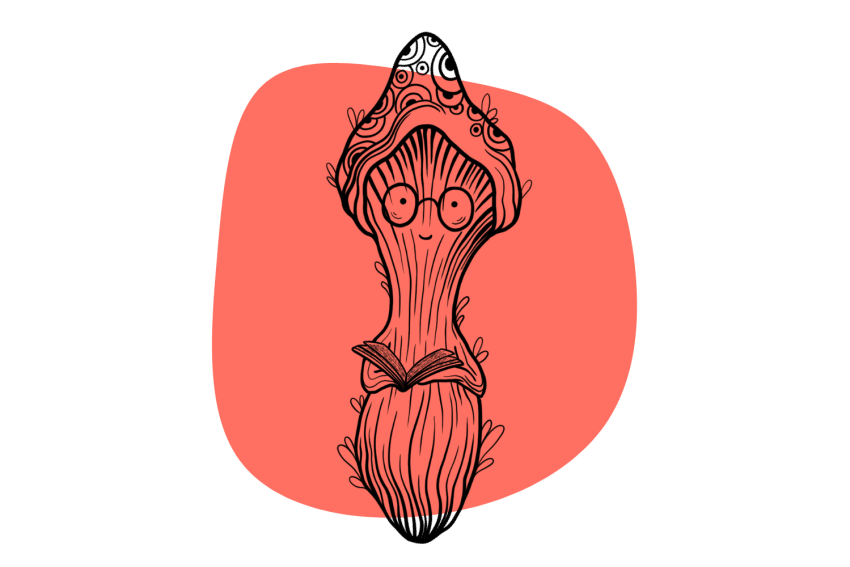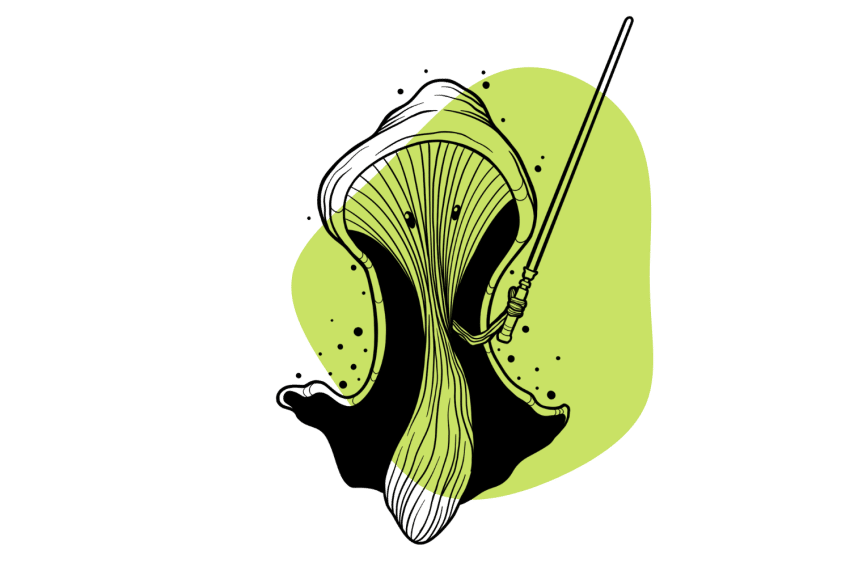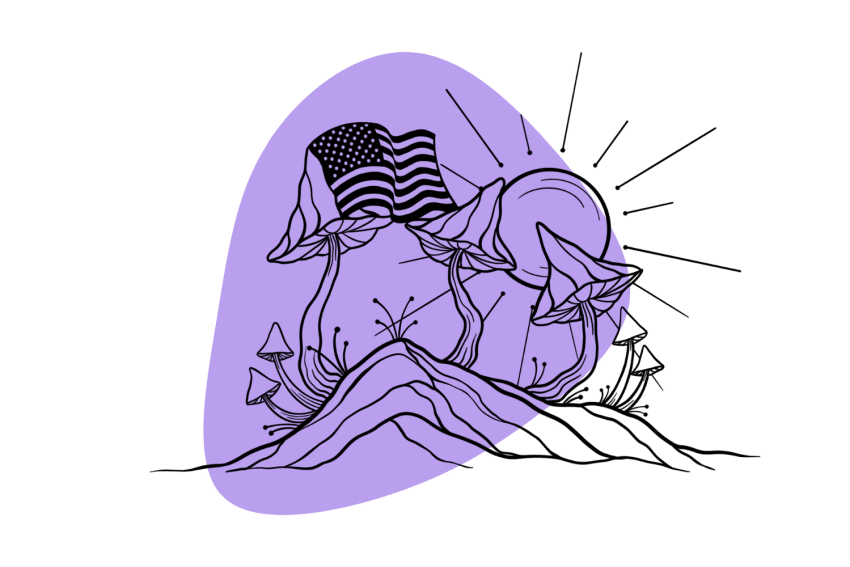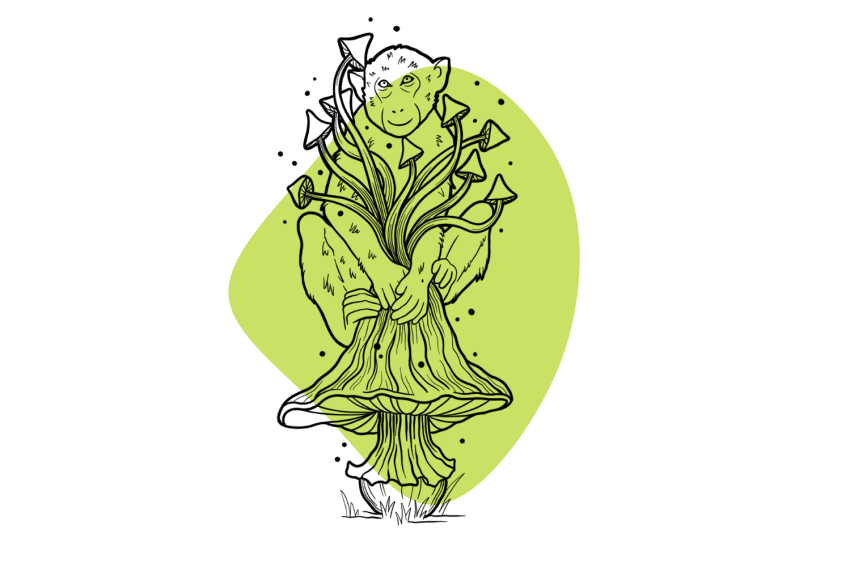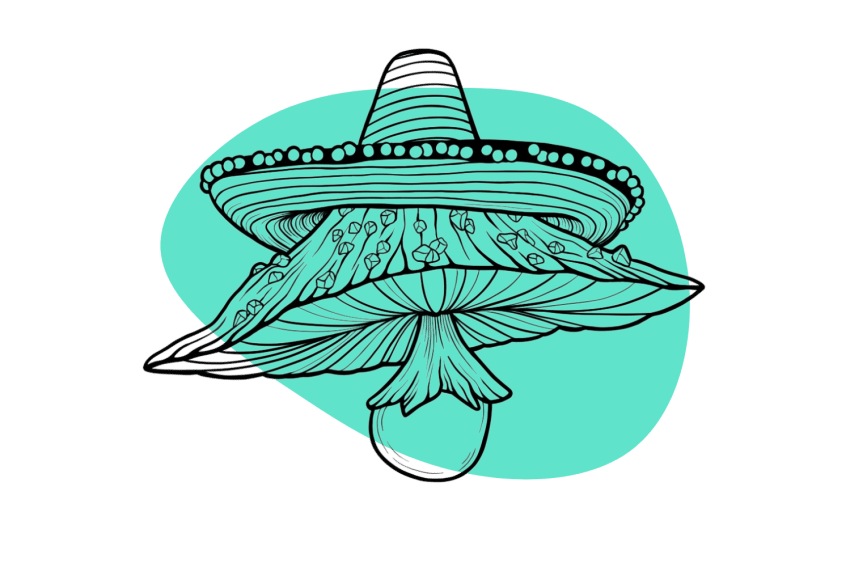The Ultimate Guide to the Wavy Cap (Psilocybe cyanescens)
A potent mushroom common around the Northern forests of Canada and Europe— but poisonous lookalikes mean you’d better leave foraging to the pros.
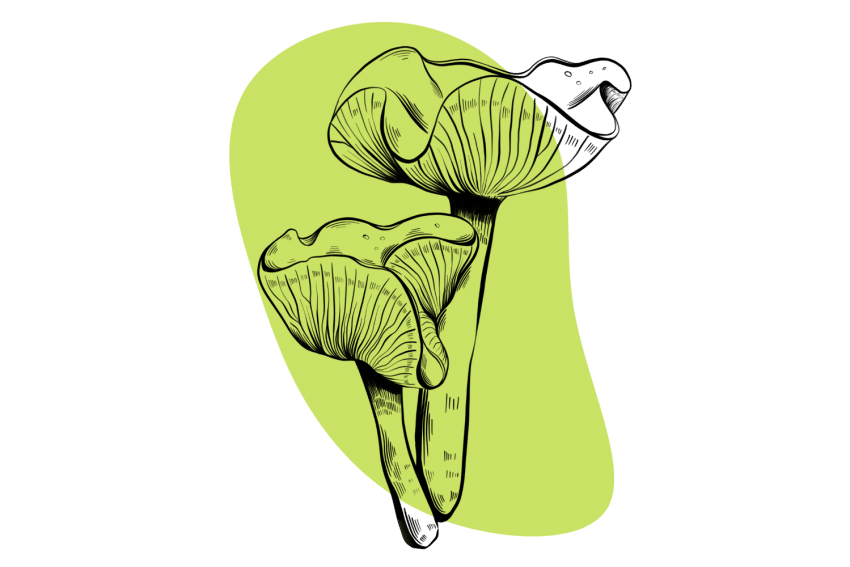
Psilocybe cyanescens, known as the Wavy Cap, is a species of psilocybin-containing mushroom that grows on wood. This saprophytic mushroom gets its common name from the flat brown caps with characteristic “wavy” edges.
This species is extremely potent and found in substantially large colonies — making the harvest extremely fruitful. However, it has a few lookalikes that contain amatoxins. It’s important to know exactly how to identify Psilocybe cyanescens before foraging.
In this article, we’ll look at this species in depth — where it grows, what it looks like, its potency, how to cultivate it, and much more.
What Are Psilocybe cyanescens Mushrooms?
Psilocybe cyanescens (also called Wavy Caps) is a psychedelic mushroom species containing the psychoactive compound psilocybin.
Looks-wise, this species is quite unique. They have large flat brown caps that become wavy as they mature. Creamy-colored gills and a white stem make this shroom particularly attractive.
This psilocybin mushroom is a favorite because several expansive colonies often grow in relatively small areas. It’s an extremely prolific producer and an aggressive colonizer. If you find one cap, you’ll likely find tens, if not hundreds, more growing in close proximity.
It’s also saprophytic — meaning it gets its food by absorbing dissolved organic matter.
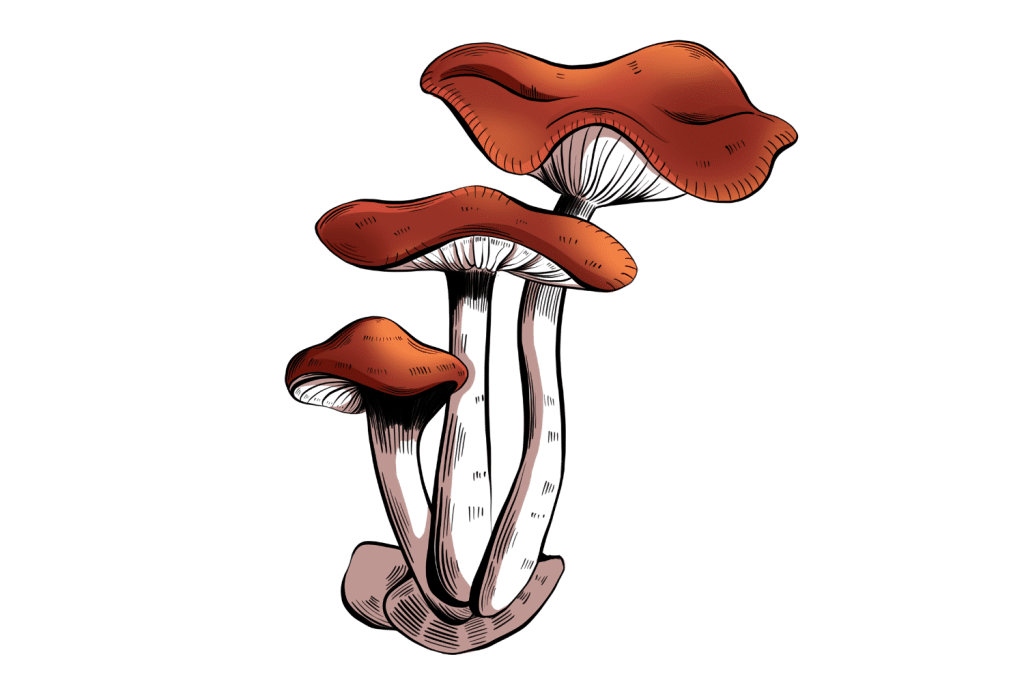
This Psilocybe species isn’t as well known as Psilocybe cubensis or Psilocybe semilanceata (Liberty Caps), but it’s slowly growing in popularity.
This mushroom has entered the wider eye of the mushroom community because of Paul Stamets infamous book titled “Growing Gourmet and Medicinal Mushrooms.” The book describes how this species effortlessly thrives on wood chips in simple garden vegetable beds — an attractive trait for the mushroom connoisseur that wants to cultivate psychedelic shrooms outside.
Psilocybe cyanescens is relatively potent, with psilocybin levels comparable to potent strains of Psilocybe cubensis. With excellent contamination resistance and the will to survive almost anywhere where there’s rotting wood, it’s no wonder this psychedelic mushroom is gaining attention.
The History of Psilocybe cyanescens
The history and origins of Psilocybe cyanescens are rather blurry. British mycologist Elsie Maud Wakefield first described the species in 1838. Wakefield gave the Wavy Cap shroom its binomial name Psilocybe cyanescens.
Other than this extremely limited information, there’s very little in terms of the taxonomic history of this species. As far as the history books describe, Wakefield’s encounter with the shroom in 1838 was the first. However, this is extremely unlikely.
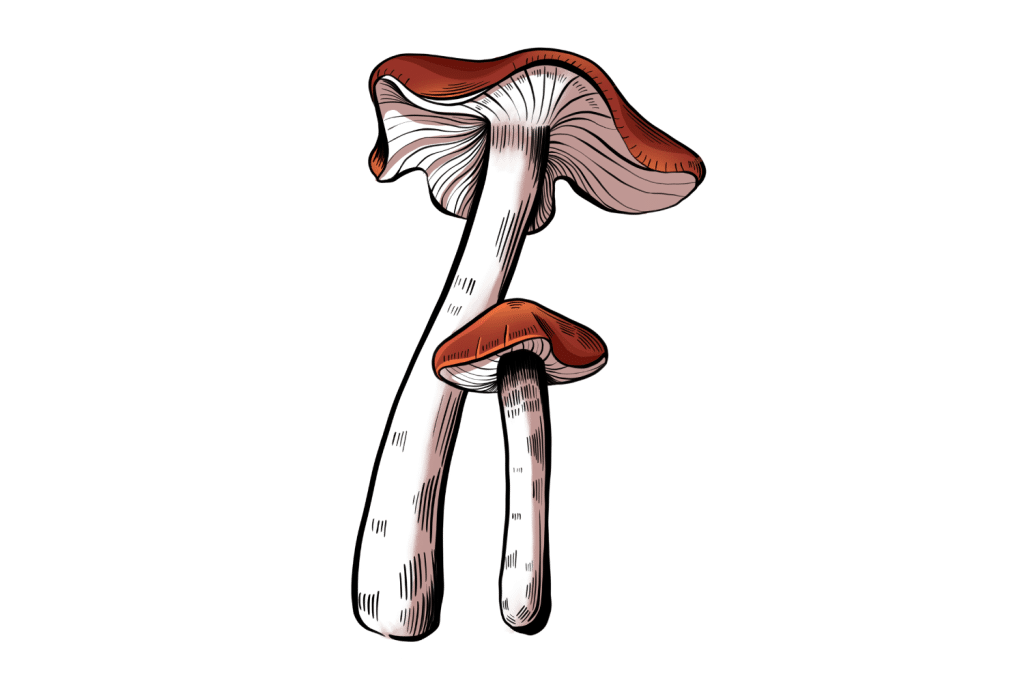
It’s believed that Psilocybe cyanescens originated in the United States and was transported to mainland Europe and the United Kingdom. This would make the species non-native to the European countryside. However, this is also debated since some believe it originated in Central Europe and was introduced to the Pacific Northwest.
We’ll never really know who or how this species was first discovered and how it spread. It doesn’t seem to have a history of usage. Regardless, we do know a lot of other things about the species, including where it grows and its potency.
Where Do Wavy Caps Grow?
Psilocybe cyanescens grows on rotting wood, the woodland floor, mulch, and on vegetable beds across the globe. It’s found in deciduous and coniferous forests, but it prefers growing on wood from deciduous trees.
You’ll also find this species growing in urban areas, town parks, and land that is utilized for vegetable growing — especially in mulch piles or wood chip-covered beds. This species loves the cold and is found predominantly in the Northern Hemisphere and is common across Europe, the United Kingdom, the United States, and Canada.
In Europe, the countries with the densest populations of P. cyanescens are Germany, the Netherlands, Belgium, the United Kingdom, the Czech Republic, France, and most counties in the East of Europe. The species has also been observed in parts of Scandinavia, specifically in Denmark and southern Sweden.
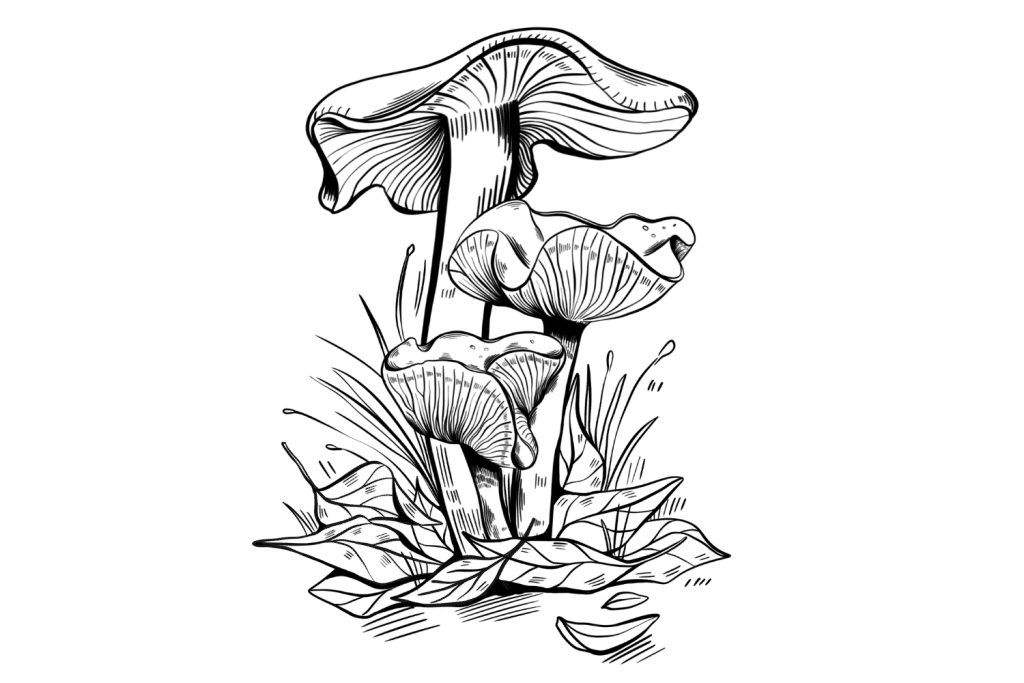
The most densely populated areas in North America are within the Pacific Northwest, stretching from California to Vancouver. However, they can be found across the US and Canada in smaller populations.
Fruiting is triggered by significant drops in temperature. It grows between October to December, sometimes into January, depending on where you live.
How to Identify Psilocybe cyanescens
Psilocybe cyanescens is relatively easy to identify thanks to its characteristic wavy caps, cream-colored gills, and white stem that bruises blue when damaged. The stems should be white to cream in color, and the caps will range from one to three centimeters in diameter.
However, there are a few other wood-loving species of mushrooms that look similar. Many of the similar species may not be lethal but could be highly toxic.
If you’re going to head out into nature in search of this fungus, it’s extremely important that you know exactly what to look for. Due to the similar species that could live close by in your area, you should take great care when foraging mushrooms. Head out with someone that’s successfully foraged them before, or get a detailed identification guide at the very least.
Never eat a mushroom unless you’re 100% certain of its identity. You shouldn’t rely solely on this short section to identify Psilocybin cyanescens.
There are two things you can do to help identify P.cyanescens. Although these identification methods alone aren’t enough to provide a positive identification of the species, they’re extremely valuable in the ID process.
1. Bruise the Stem
When you pick what you believe is P.cyanescens, give the stem a couple of pinches up its length. Then, wait for 10 minutes or so. If you start to see a blue coloration appear, there’s a good chance it’s a Psilocybe mushroom.
2. Take a Spore Print
If the mushrooms bruise blue, take a spore print or two of some of the mushrooms you’ve collected when you’re home. The spore prints should be purple-black in color. However, be warned, some lookalikes also produce similar-colored spore prints.
I thoroughly recommend purchasing a decent mushroom foraging guide if you are going to go in search of this mushroom because of the many lookalikes it has.
Wavy Cap Lookalikes
There are several mushrooms that look similar to Psilocybe cyanescens. Confusing P.cyanescens with one of these lookalikes could prove fatal.
Galerina Species — the Most Dangerous
The most concerning group of “lookalike” species comes from the Galerina genus. Species of mushrooms within this genus produce amatoxins — poisonous compounds that are unique to fungi.
Galerina species closely resemble young Psilocybe cyanescens mushrooms. They have a similar caramel-colored cap and can develop undulating waves. However, they have a brown stem with an annulus (a ring-like collar found on the stem of the fungus).
Misidentifying a Galerina species for P. cyanescens can cause a quick demise and, in some cases, death. The amatoxins within their flesh are the very same that is within the flesh of the infamous Death Cap (Amanita phalloides).
Amatoxins can cause nausea and severe vomiting a couple of hours after ingestion. In many cases, the body rids itself of these toxins within a day, and most people recover. However, other people may experience no symptoms at all — this is where the effects of amatoxins can become more sinister.
Your body’s response to consuming amatoxins is to vomit to rid itself of the poison. However, if the body doesn’t respond to the toxins by vomiting and you get no symptoms, they can begin to cause irreparable damage to the liver and kidneys. If this goes unnoticed, things can get rather serious.
If left untreated, you can become extremely weak and develop a serious illness a couple of days after ingesting the amatoxins. Often, it’s too late to recover from the poison by this time, and soon after becoming weak, the organs fail — causing death in many cases.
If you’re an inexperienced forager, we advise against going in search of Psilocybe cyanescens. You must ensure that you’re 100% sure of the mushroom’s identity before putting it anywhere near your mouth.
Other Harmful Species
Mushrooms from the genera Hypholoma, Cortinarius, and Leratiomyces share similar traits to Wavy Caps. Although considered less harmful than mushrooms from the Galerina genus, some species can be poisonous — potentially causing liver and kidney damage after ingestion.
The problem with many of these lookalike species is the fact that they also produce a very similar spore print to Psilocybe cyanescens. Many similar wood-loving species produce purple-black spore prints — usually a good identifier for Psilocybe species, but perhaps not in this case.
As you can see, this species has a fair few potentially dangerous lookalikes. It only takes a single false identification to end up poisoning yourself. If you’re new to foraging, it’s probably best to steer clear of Psilocybe cyanescens and target a more easily identifiable species such as Psilocybe semilanceata (Liberty Caps).
The Potency of Psilocybe cyanescens
Psilocybe cyanescens is a potent psilocybin mushroom comparable to strains such as Penis Envy and B+. However, being a wild species, the exact psilocybin levels can vary drastically.
It seems that the geographical location where the shrooms are collected can have some kind of effect on potency. Samples collected from the Czech Republic in Europe have produced phenomenal psilocybin levels, whereas samples from elsewhere in Europe have produced less.
It’s believed that the variation in psilocybin levels in this species could be down to different growing substrates. P.cyanescens grows in a variety of different environments in different substrates. Whether a shroom grows directly on wood or in mulch could affect the alkaloid concentrations within the fungi.
Beug and Bigwood tested samples of Psilocybe cyanescens from the Pacific Northwest to discover the psilocybin and psilocin levels within the flesh of the fruits in 1982 [1]. They found a dry-weight psilocybin content of between 0 to 1.68% and a dry-weight psilocin level of between 0.06 to 0.96% — that’s a huge variation in potency.
In a 1985 analysis of Psilocybe cyanescens by T Stijve and T W Kuyper, samples collected from Europe also produced varied potency results [2]. The psilocybin levels of dry P.cyanescens were in the range of 0.1 to 0.80%, and psilocin levels were between 0.04 and 0.47%. This is again a lot of variation and a lower range than Beug and Bigwood’s results from the mushrooms found in the Pacific Northwest.
Another paper looking into the potency of Psilocybe cyanescens written by J Stríbrný, J Borovicka, and M Sokol (three Czechian scientists) found a significant variation in psilocybin and psilocin levels in the species [3].
Several samples of P.cyanescens were collected from the Czech Republic and tested. Psilocybin levels ranged from 0.13 to a staggering 1.84%, and psilocin levels ranged from 0.28 to a massive 1.81%.
The higher end of those ranges is extremely impressive. However, the huge variation in psilocybin levels from one shroom to the next is worrying, especially in terms of working out dosages.
What’s the Dose of Psilocybe cyanescens?
Due to the potential strength of Psilocybe cyanescens, an effective psychedelic dose is far lower in mushroom weight than the psychoactive dose of Psilocybe cubensis. The varied potency levels from shroom to shroom can also make it difficult to gauge what an effective dose is.
Unfortunately, it’s hard to provide a dosage guide due to the extreme variations in psilocybin levels from one mushroom to the next. The only way to work out an effective dose is to gauge it yourself.
Start off with an extremely small amount (around half a gram or so) of dried mushroom, and slowly increase the dose until you achieve the desired effects. There really is no need to rush when it comes to consuming this species.
Proceed with caution and always leave an hour and a half in between re-doses — this will ensure that the previous dose has had time to take effect.
Can You Microdose Wavy Cap Mushrooms?
The exact dose will depend on various factors such as body weight, tolerance, and metabolism. An effective microdose is usually somewhere between 50 and 100 milligrams.
However, this can be hard to calculate due to this species’ potency variation. This can be both a pro and a con for the person that wants to use magic mushrooms to microdose.
On the one hand, the high potency means you’ll consume far less organic matter when consuming a sub-psychedelic dose. This makes it far easier to fit single microdoses of dry ground mushrooms into small capsules or less hassle to ingest the un-powdered organic matter orally.
There’s also far less of a chance of nausea — a trait that’s attractive to people with weaker stomachs.
On the other hand, it can be quite easy to consume a psychoactive dose when attempting to take a microdose — this is not ideal if you want to consume microdoses mid-week when you have to get on with your day-to-day activities.
It’s best to start with a very small amount and make notes of the effects, so you can narrow down the right amount.
How Can Psilocybe cyanescens be Consumed?
Psilocybe cyanescens can be consumed in several different ways. Of course, the mushrooms can be eaten whole, either fresh or dried, but that’s not the only way you can take them.
The options for cooking with magic mushrooms are endless. You can make all sorts of psychedelic meals, such as shroom pizza, using psilocybin-containing mushroom species.
You can also make psilocybin edibles or brew a shroom tea that can produce an intense psychedelic trip. This is also a fantastic way to even out the potency of your doses, seen as the psilocybin levels of P.cyanescens can be so varied.
Magic mushroom tea kicks in a lot faster than eating the mushrooms raw when fresh or dried. This gives you some control over your experience.
If you want a sudden and intense come-up, you can drink the tea quickly. However, if you want to control the intensity of your trip and ensure you don’t consume too much, drink the tea slowly as you come up and stop drinking once you’ve reached your desired “level.”
Dried Wavy Caps can also be powdered and divided up into psychedelic or sub-perceptual doses (microdoses). Each dose can be placed in dissolvable pill capsules for a tasteless, easy way to consume psilocybin.
Are Wavy Caps Risky to Eat?
As with any substance, consuming this species of magic mushroom is associated with risks.
1. Wavy Caps Are Difficult to Dose
Although there are no current reports of a psilocybin overdose, you can take too much, which is unlikely to prove fatal, but it can definitely be dangerous. If you consume too much psilocybin, you run the risk of having a terrifying experience.
Due to the extreme potency of these shrooms, it can be easy to consume a dose that will be uncomfortable, to say the least. The best way to avoid a bad trip is to start with a small amount and work it up gradually. It’s also crucial that you’re in the right headspace (set) and in a welcoming environment (setting) when you consume psychedelics.
2. Wood-Lover’s Paralysis
There’s another risk associated with Psilocybe cyanescens that you don’t get with some other species of psychedelic mushrooms — a phenomenon called Wood-Lovers Paralysis, or WLP for short [4].
Although relatively rare, this bizarre effect can be extremely frightening.
Reportedly, the effects of WLP can occur within an hour or two after ingesting wood-loving psilocybin-containing fungi. People can encounter muscle weakness and loss of motor control that can last until the next day.
Not everyone experiences this, but enough have encountered the phenomenon for it to be widely discussed on mushroom forums and social media groups. It’s currently unknown why Wood Lovers Paralysis occurs, but there are a couple of theories.
The most likely explanation involves the compound aeruginascin — a compound similar to psilocybin that has been identified in certain Psilocybe species. The main theory is that aeruginascin undergoes similar dephosphorylation as psilocybin does when it converts to psilocin.
If this occurs, aeruginascin could potentially convert to a compound that’s extremely similar to the toad venom bufotenine, which is known to cause paralysis.
Although we’re still unsure exactly why Wood Lover’s Paralysis exists, it’s important to know the risks. No reported fatalities are associated with this phenomenon, and the effects are relatively short-lived. However, it can be a scary feeling, especially while on a psychedelic trip.
Can Psilocybe cyanescens be Cultivated?
Psilocybe cyanescens can be difficult to cultivate effectively indoors. However, due to its aggressive colonization traits, excellent contamination resistance, and prolific fruiting, it’s possible to successfully cultivate the species outdoors without much effort.
This species can be grown in simple vegetable beds full of mulch or wood chips. There’s no need for fancy cultivation techniques, heat mats, and fruiting chambers for this psychedelic fungi.
The following steps can help you grow this species outside.
1. Find a Colony Growing In Nature
If you can find a colony of P.cyanescens growing naturally in a local forest, removing a small amount of the substrate that holds the mycelium will allow you to grow them in your backyard.
If you find the mushrooms growing in a piece of deadwood, break off a small piece of wood with a few mushrooms still attached. This way you can introduce the species to some substrate at home. The small colony can be “planted” in a bed full of mulch or wood chip in a shaded area and left for nature to do the rest.
If you do this, don’t be greedy and take a huge chunk. Leave plenty in the forest to do its thing — these mushrooms are extremely beneficial to the woodland environment.
2. Keep the Growing Area Moist
Very little care is needed if you cultivate P.cyanescens this way. Just ensure that the growing area remains moist but not saturated.
3. Leave It Alone
You can then leave the patch undisturbed until next autumn. By the next season, the mycelium should have hopefully taken hold of the substrate, and you should start seeing Wavy Caps start to emerge from the ground when the conditions permit fruiting.
4. Or…Use a Spore Syringe
If you don’t live near a good patch of Wavy Caps, you can inoculate the substrate by using a spore syringe. This is a little more technical but not too difficult. This species can be cultivated in the same way as other wood-loving mushrooms can be.
If you’re interested in cultivating Psilocybe cyanescens, I’d recommend reading Stamets’ book titled “Mycelium Running.” The book has detailed instructions on growing species such as Stropharia rugosoannulata and Lepista nuda — two wood-loving mushroom species. Use the method described in the book to grow Wavy Caps.
Related: Where to Buy Magic Mushroom Spores
Is Psilocybe cyanescens Legal?
Psilocybe cyanescens is a species of magic mushroom. The psychoactive compound within this fungus is psilocybin. Although psilocybin is being thoroughly researched for its potential benefit in psychedelic-assisted therapy, it still remains illegal in many countries.
Apart from places such as Jamaica, The Netherlands, and Brazil, psilocybin is illegal to consume, produce, distribute, and possess.
Most of Europe, Canada, the majority of the United States, and the whole of the United Kingdom have listed psilocybin as a controlled substance. As it stands, the possession of psilocybin in these countries is a criminal offense. If you’re caught with psilocybin-containing mushrooms such as Psilocybe cyanescens, you could face hefty fines and/or prison time.
There are a few exceptions, however…
Spores are legal in many places, and you can buy them online. Just note that cultivating them is usually illegal.
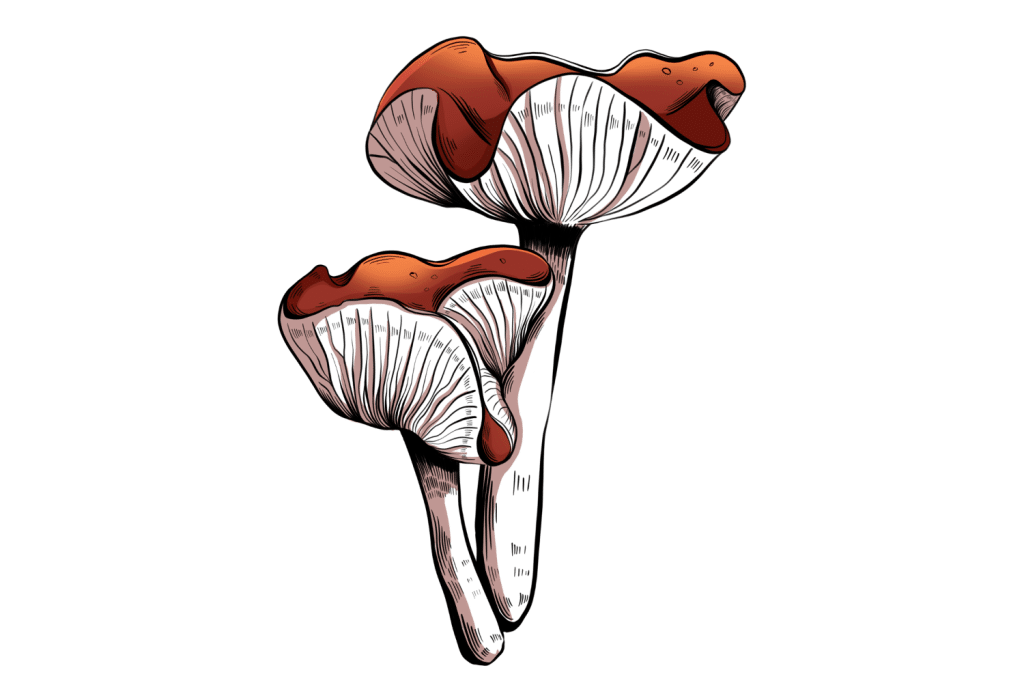
Although in Canada, psilocybin remains illegal, several dispensaries openly sell them. It seems that, similar to places such as the Netherlands, the Canadian government turns a blind eye to soft drug use.
In the United States of America, psilocybin has also been decriminalized in some states. The states of Oregon, Colorado, and Massachusetts have decriminalized magic mushrooms. Other states, such as California, have also eased restrictions in certain areas.
A Final Word: The Potent Wavy Cap Mushroom
The Wavy Cap (Psilocybe cyanescens) is a potent species of psilocybin-containing fungi. However, their potency can vary greatly from one shroom to the next, making it extremely difficult to calculate doses accurately.
This species grows in abundance on wood, mulch, and in wood chip. If you find one Wavy Cap you’ll often find tens, if not hundreds more. However, foraging for them can be risky business. Psilocybe cyanescens has several lookalikes, some of which contain deadly amatoxins that can cause organ failure and in some cases, death.
If you’re going to go in search of this potent psilocybe mushroom, make sure you’re 100% sure about how to identify it. Even spore prints can be misleading, with other toxic lookalike species producing the similar purple-black coloration that’s so common with psilocybin-containing mushroom species.
If in doubt, throw it out.
References
- Beug, M. W., & Bigwood, J. (1982). Psilocybin and psilocin levels in twenty species from seven genera of wild mushrooms in the Pacific Northwest, USA. Journal of ethnopharmacology, 5(3), 271-285.
- Stijve, T., & Kuyper, T. W. (1985). Occurrence of psilocybin in various higher fungi from several European countries. Planta medica, 51(05), 385-387.
- Stríbrný, J., Borovicka, J., & Sokol, M. (2003). Levels of psilocybin and psilocin in various types of mushrooms. Soudni Lekarstvi, 48(3), 45-49.
- Van Court, R. C., Wiseman, M. S., Meyer, K. W., Ballhorn, D. J., Amses, K., Slot, J. C., … & Uehling, J. K. (2022). Diversity, biology, and history of psilocybin-containing fungi: Suggestions for research and technological development. Fungal Biology.

